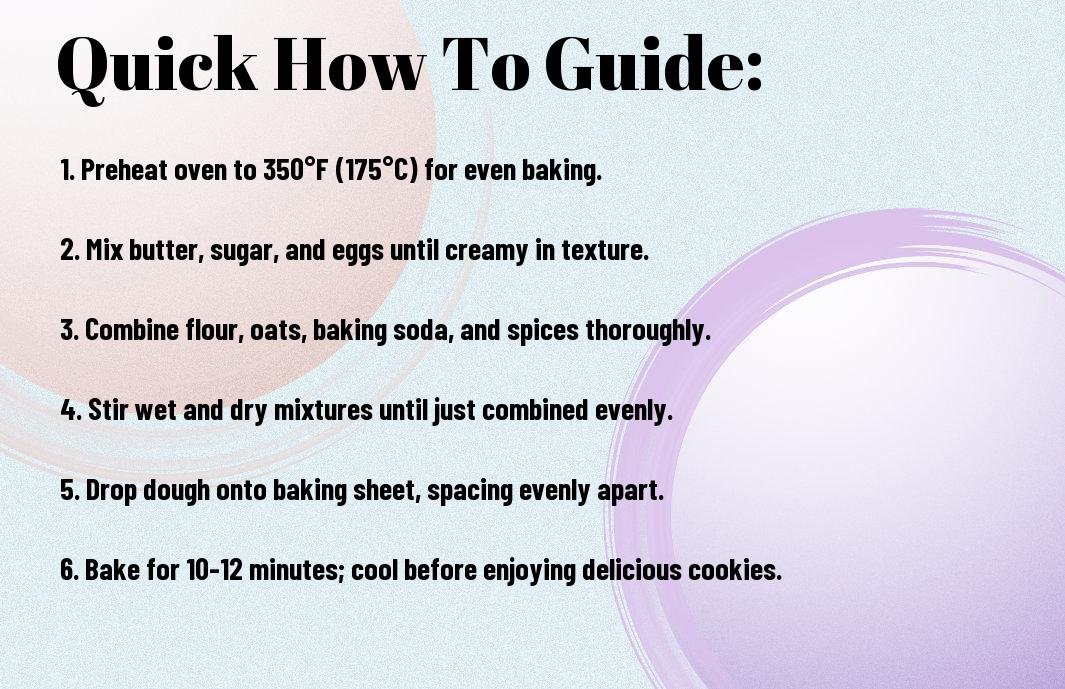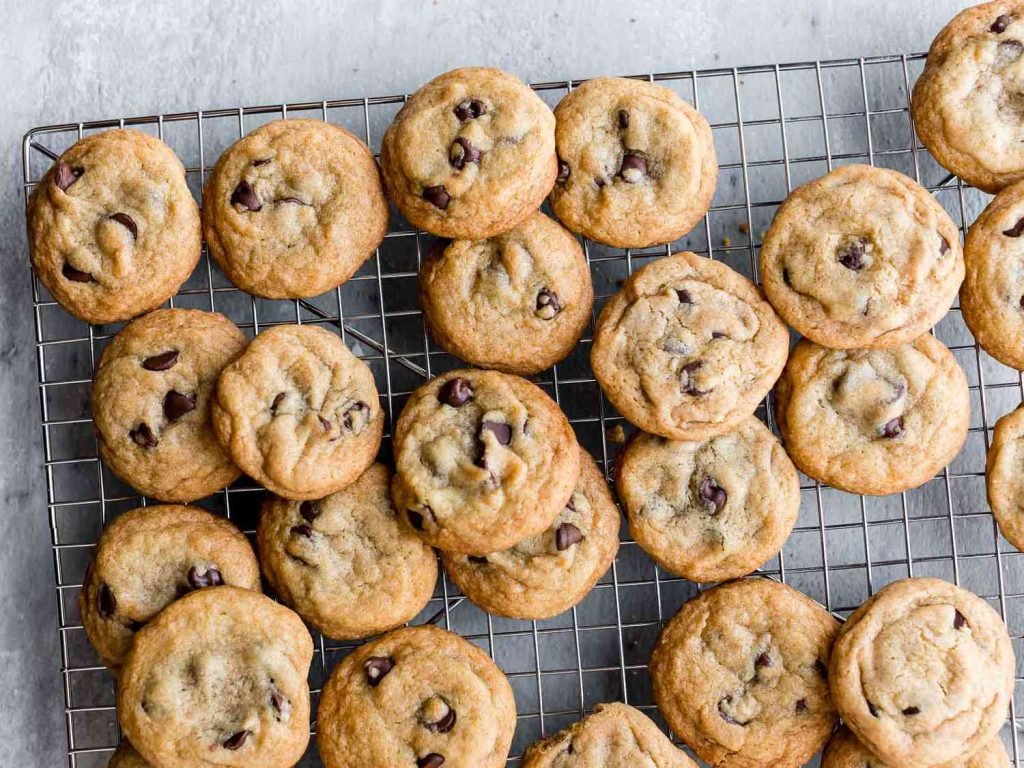This classic Quaker Oats oatmeal cookie recipe is my go-to for achieving chewy perfection every time. I’ll guide you through the simple steps to create delicious, soft, and flavorful cookies that are sure to impress your family and friends. With the right ingredients and techniques, you’ll unlock the secrets to a classic treat that offers comfort and satisfaction in every bite. Let’s get started on baking these delightful cookies that will surely become a staple in your home!
Understanding Ingredients
To create the ultimate chewy oatmeal cookie, it’s vital to understand the role each ingredient plays. The right combinations not only enhance flavor but also affect texture and consistency. From oats to sugars, every component contributes to achieving that perfect bite. By mastering these ingredients, you can elevate your cookie game and impress your family and friends with a classic treat that’s a joy to bake and eat.
Choosing the Right Oats
An important aspect of your oatmeal cookie recipe is selecting the right oats. Rolled oats are my go-to choice for their ability to absorb moisture while providing that signature chewiness. Steel-cut oats, while nutritious, can result in a gritty texture, and quick oats may lead to a cookie that’s too soft. By choosing rolled oats, you’re ensuring the perfect balance of texture in your chewy cookies.
The Role of Brown Sugar
If you want your cookies to have a rich flavor and moist texture, brown sugar is the key ingredient. This type of sugar contains molasses, which not only lends a deep sweetness but also helps retain moisture during baking. The result is a delightful chewiness that elevates your cookies beyond the ordinary.
A balance of both light and dark brown sugar can deepen the flavor profile of your cookies significantly. The higher moisture content in brown sugar maintains chewy texture, while its natural caramel notes add complexity. Just be cautious with the amount, as too much can overwhelm the other flavors. Striking the right balance allows your cookies to shine, making them deliciously satisfying with every bite.

How to Prepare Your Dough
If you want your oatmeal cookies to turn out perfectly chewy, start by creaming your butter and sugars together until light and fluffy. This step incorporates air into the mixture, giving your cookies a tender texture. Once combined, add in your eggs one at a time, followed by the vanilla extract to infuse flavor. Finally, mix in your dry ingredients, including the oats, to achieve that classic oatmeal cookie consistency.
Mixing Techniques for Chewy Cookies
For the best chewy oatmeal cookies, it’s important to mix your dough gently. Overmixing can result in tough cookies, so I recommend using a spatula or wooden spoon to fold in the dry ingredients just until combined. The goal is to keep the mixture slightly uneven to maintain that delightful chew in every bite.
Measuring Ingredients Accurately
To ensure your oatmeal cookies turn out as intended, accurate measurement of ingredients is key. Using the correct tools and methods will give you the desired texture and flavor.
For instance, when measuring flour, I use the spoon and level method. I spoon the flour into a measuring cup without packing it down, then level it off with a knife. This prevents excess flour, which could lead to dry cookies. Additionally, when measuring brown sugar, make sure to pack it firmly into the measuring cup to achieve the correct sweetness and moistness in your cookies. Paying attention to these details will make a significant difference in your final product.
Baking Tips for Perfection
Many factors can determine the success of your oatmeal cookie recipe. Here are a few tips for achieving that chewy texture:
- Use old-fashioned oats for the best consistency.
- Let your butter soften at room temperature.
- Don’t overmix your dough to maintain chewiness.
- Use brown sugar for added moisture and flavor.
Knowing these tips will elevate your baking experience and deliver remarkable results.
Oven Temperature and Timing
Any successful oatmeal cookie depends heavily on the oven temperature and timing:
| Temperature | Time |
|---|---|
| 350°F | 10-12 minutes |
When baked at the right temperature and for an appropriate duration, your oatmeal cookies will be perfectly chewy and delicious.
Cooling Recommendations
Any cookie lover knows that cooling is just as important as baking. I suggest letting your cookies cool on the baking sheet for about 5 minutes before transferring them to a wire rack. This allows them to set, ensuring they retain their chewy texture.
A proper cooling process is crucial for achieving the ideal cookie consistency. If you transfer them too soon, they might fall apart, ruining your hard work. Allowing your cookies to cool gradually helps them to firm up and develop their signature chewy perfection. Be patient, as this step will significantly enhance your overall cookie experience.
Factors Affecting Chewiness
Now, understanding the key factors affecting the chewiness of your oatmeal cookies can make all the difference. Here are some necessary elements to consider:
- Moisture content
- Ingredient ratios
- Baking time
- Add-ins
This guide will help you achieve the perfect chewy texture every time.
Moisture Content
Even slight variations in the moisture content can impact the chewiness of your cookies. Higher moisture levels create a softer and chewier texture, while drier dough can lead to crumblier results. I suggest adding ingredients like brown sugar or even a splash of milk to increase moisture.
Add-ins and Variations
Any variation in add-ins can significantly alter the chewiness of your cookies. I recommend experimenting with ingredients like chocolate chips, nuts, or dried fruits to create unique flavor combinations. You can even use oat flour for a different texture!
Addins like chocolate chips or nuts not only enhance flavor but also contribute to the chewiness of your oatmeal cookies. By incorporating mix-ins, you can create your signature cookie style. However, keep in mind that the ratio of these ingredients can influence the dough’s overall moisture and texture. I recommend balancing heavier add-ins with sufficient moisture-dense ingredients to maintain that desired chewiness. With careful selection and experimentation, you can create oatmeal cookies that are not just delicious, but also uniquely yours.
Storage and Shelf Life
Keep your delicious Quaker Oats oatmeal cookies fresh and tasty by storing them in an airtight container at room temperature. They can last up to one week, but I recommend enjoying them sooner for the best flavor and texture. If you want to prolong their shelf life, freezing is an excellent option!
Keeping Cookies Fresh
Fresh cookies can be tricky to keep at their peak quality. To maintain their chewiness, I suggest lining your storage container with parchment paper and placing a slice of bread inside. The bread will help retain moisture, keeping your cookies soft and delightful even after a few days.
Freezing Techniques
Little did I know, freezing oatmeal cookies allows you to enjoy them later without sacrificing quality. Proper freezing techniques ensure that your cookies remain irresistible when you’re ready for a treat!
This method works best if you allow your cookies to cool completely before freezing. I recommend placing them in a single layer on a baking sheet and popping them in the freezer for about an hour before transferring them to a freezer-safe container. Make sure to space them out if you’re stacking them to avoid sticking together. If stored correctly, your cookies can last for up to three months in the freezer while maintaining their delectable texture and flavor. When you’re ready to enjoy them, simply let them thaw at room temperature, or warm them in the oven for a few minutes for a fresh-baked experience!
Troubleshooting Common Issues
Once again, baking can sometimes present challenges even to the most enthusiastic cookie creator. Whether your cookies are too flat or too hard, identifying the problem is important for perfecting your Quaker Oats oatmeal cookies. Let’s address a couple of common issues you may encounter to ensure your baking experience is rewarding and your cookies end up just right.
Cookies Spreading Too Much
Issues with cookie spread can stem from several factors. If you notice your cookies spreading excessively, ensure that you are measuring your ingredients accurately, particularly the flour. A lack of flour will lead to a runny dough, causing the cookies to spread more than you’d like. Also, chilling your dough for at least 30 minutes can help prevent this unwanted spread by allowing the fats to firm up before baking.
Maintaining Texture
While it’s tempting to tweak the recipe, maintaining the right texture is key to achieving chewy oatmeal cookies. Using old-fashioned rolled oats rather than quick oats contributes to the desired texture, and chilling the dough can help as well. Adding a touch of cornstarch may also enhance chewiness without compromising the cookie’s structure.
Texture plays a significant role in the overall enjoyment of your cookies. To ensure they remain chewy, I recommend checking your baking time; overbaking can lead to dry cookies. Aim for a golden brown color on the edges while keeping the center slightly soft. Additionally, letting the cookies cool on the baking sheet for a few minutes before transferring them to a wire rack helps maintain their moisture. By following these tips, your oatmeal cookie texture will be nothing short of perfection.
Final Words
So, as you initiate on your journey to create the Classic How-To Quaker Oats Oatmeal Cookie Recipe for chewy perfection, embrace the process and enjoy the delightful aroma that fills your kitchen. By following the steps I’ve shared, you’ll not only craft cookies that are wonderfully chewy but also create lasting memories with each batch you bake. Trust your instincts, and feel free to customize the recipe to suit your taste. Happy baking, and may your kitchen be filled with the warmth of delicious homemade cookies!

